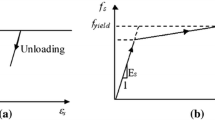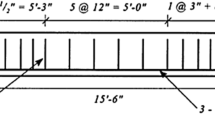Abstract
This study presents a numerical investigation on the fracture mechanism of tension stiffening phenomenon in reinforced concrete members. A novel approach using the discrete element method (DEM) is proposed, where three-dimensional randomly generated distinct polyhedral blocks are used, representing concrete and one-dimensional truss elements are utilized, representing steel reinforcements. Thus, an explicit representation of reinforced concrete members is achieved, and the mechanical behavior of the system is solved by integrating the equations of motion for each block using the central difference algorithm. The inter-block interactions are taken into consideration at each contact point with springs and cohesive frictional elements. Once the applied modeling strategy is validated, based on previously published experimental findings, a sensitivity analysis is performed for bond stiffness, cohesion strength, and the number of truss elements. Hence, valuable inferences are made regarding discontinuum analysis of reinforced concrete members, including concrete–steel interaction and their macro behavior. The results demonstrate that the proposed phenomenological modeling strategy successfully captures the concrete–steel interaction and provides an accurate estimation of the macro behavior.


















Similar content being viewed by others
References
Massicotte B, Elwi AE, MacGregor JG (1990) Tension stiffening model for planar reinforced concrete members. J Struct Eng 116:3039–3058
Ožbolt J, Lettow S, Kožar I (2002) Discrete bond element for 3D finite element analysis of reinforced concrete structures. In: Proceedings of 3rd International Symposium Bond Concr. Res. to Stand, pp 1–11
Wu HQ, Gilbert RI (2009) Modeling short-term tension stiffening in reinforced concrete prisms using a continuum-based finite element model. Eng Struct 31:2380–2391. https://doi.org/10.1016/j.engstruct.2009.05.012
Lowes LN, Moehle JP, Govindjee S (2004) Concrete-steel bond model for use in finite element modeling of reinforced concrete structures. ACI Struct J 101:501–511. https://doi.org/10.14359/13336
Stramandinoli RSB, La Rovere HL (2008) An efficient tension-stiffening model for nonlinear analysis of reinforced concrete members. Eng Struct 30:2069–2080. https://doi.org/10.1016/j.engstruct.2007.12.022
Michou A, Hilaire A, Benboudjema F et al (2015) Reinforcement-concrete bond behavior: experimentation in drying conditions and meso-scale modeling. Eng Struct 101:570–582. https://doi.org/10.1016/j.engstruct.2015.07.028
Slobbe AT, Hendriks MAN, Rots JG (2012) Sequentially linear analysis of shear critical reinforced concrete beams without shear reinforcement. Finite Elem Anal Des 50:108–124. https://doi.org/10.1016/j.finel.2011.09.002
Vecchio FJ, Shim W (2004) Experimental and analytical reexamination of classic concrete beam tests. J Struct Eng 130:460–469. https://doi.org/10.1061/(ASCE)0733-9445(2004)130:3(460)
Grassl P, Johansson M, Leppänen J (2018) On the numerical modelling of bond for the failure analysis of reinforced concrete. Eng Fract Mech 189:13–26. https://doi.org/10.1016/j.engfracmech.2017.10.008
Murcia-Delso J, Benson Shing P (2015) Bond-slip model for detailed finite-element analysis of reinforced concrete structures. J Struct Eng (United States) 141:1–10. https://doi.org/10.1061/(ASCE)ST.1943-541X.0001070
Jendele L, Cervenka J (2006) Finite element modelling of reinforcement with bond. Comput Struct 84:1780–1791. https://doi.org/10.1016/j.compstruc.2006.04.010
Yu RC, Saucedo L, Ruiz G (2011) Finite-element study of the diagonal-tension failure in reinforced concrete beams. Int J Fract 169:169–182. https://doi.org/10.1007/s10704-011-9592-z
Lorig LJ, Cundall PA (1989) Modeling of reinforced concrete using the distinct element method. In: Shah SP, Swartz SE (eds) Fracture of concrete and rock. Springer, New York, pp 276–287
Živaljić N, Nikolić Ž, Smoljanović H (2014) Computational aspects of the combined finite-discrete element method in modelling of plane reinforced concrete structures. Eng Fract Mech 131:362–389. https://doi.org/10.1016/j.engfracmech.2014.10.017
Munjiza A, Smoljanović H, Živaljić N et al (2019) Structural applications of the combined finite–discrete element method. Comput Part Mech. https://doi.org/10.1007/s40571-019-00286-5
Kawai T (1978) New discrete models and their application to seismic response analysis of structures. Nucl Eng Des 48:207–229. https://doi.org/10.1016/0029-5493(78)90217-0
Bolander JE, Le BD (1999) Modeling crack development in reinforced concrete structures under service loading. Constr Build Mater 13:23–31
Aydin BB, Tuncay K, Binici B (2018) Overlapping Lattice Modeling for concrete fracture simulations using sequentially linear analysis. Struct Concr 19:568–581. https://doi.org/10.1002/suco.201600196
Aydin BB, Tuncay K, Binici B (2019) Simulation of reinforced concrete member response using lattice model. J Struct Eng 145:04019091. https://doi.org/10.1061/(ASCE)ST.1943-541X.0002381
De Borst R, Nauta P (1985) Non-orthogonal cracks in a smeared finite element model. Eng Comput 2:35–46. https://doi.org/10.1108/eb023599
Bernardi P, Ferretti D, Michelini E, Sirico A (2016) Evaluation of crack width in RC ties through a numerical “range” model. Procedia Struct Integr 2:2780–2787. https://doi.org/10.1016/j.prostr.2016.06.347
Rots JG, Belletti B, Invernizzi S (2008) Robust modeling of RC structures with an “event-by-event” strategy. Eng Fract Mech 75:590–614. https://doi.org/10.1016/j.engfracmech.2007.03.027
Ensink SWH, Graaf AV Van De, Slobbe AT, et al (2012) Modelling of bond behaviour by means of sequentially linear analysis and concrete-to-steel interface elements. In: Proceedings of the fourth international symposium” bond in concrete 2012: bond, anchorage, detailing”. Brescia, pp 161–167
Gijsbers FBJ, Hehemann AA (1977) Some tensile tests on reinforced concrete. Rijswijk
Walraven JC (1984) The influence of depth on the shear strength of lightweight concrete beams without shear reinforcement. University of Technology, Department of Civil Engineering
Cundall PA (1971) A computer model for simulating progressive, large-scale movements in blocky rock systems. In: The international symposium on rock mechanics. Nancy, pp 47–65
Itasca Consulting Group Inc. (2013) 3DEC three dimensional distinct element code
Pulatsu B, Erdogmus E, Lourenço PB et al (2020) Discontinuum analysis of the fracture mechanism in masonry prisms and wallettes via discrete element method. Meccanica 55:505–523. https://doi.org/10.1007/s11012-020-01133-1
Pulatsu B, Erdogmus E, Lourenço PB, Quey R (2019) Simulation of uniaxial tensile behavior of quasi-brittle materials using softening contact models in DEM. Int J Fract 217:105–125. https://doi.org/10.1007/s10704-019-00373-x
Pulatsu B, Kim S, Erdogmus E, Lourenço PB (2020) Advanced analysis of masonry retaining walls using mixed discrete-continuum approach. Proc Inst Civ Eng—Geotech Eng. https://doi.org/10.1680/jgeen.19.00225
Quey R, Dawson PR, Barbe F (2011) Large-scale 3D random polycrystals for the finite element method: generation, meshing and remeshing. Comput Methods Appl Mech Eng 200:1729–1745. https://doi.org/10.1016/j.cma.2011.01.002
Quey R (2014) Neper Reference Manual 3.5.1
Quey R, Renversade L (2018) Optimal polyhedral description of 3D polycrystals: method and application to statistical and synchrotron X-ray diffraction data. Comput Methods Appl Mech Eng 330:308–333. https://doi.org/10.1016/j.cma.2017.10.029
Quey R, Villani A, Maurice C (2018) Nearly uniform sampling of crystal orientations. J Appl Crystallogr 51:1162–1173. https://doi.org/10.1107/S1600576718009019
Lemos JV (2012) Explicit codes in geomechanics—FLAC, UDEC and PFC. In: Ribeiro e Sousa L, Vargas E Jr, Fernandes MM, Azevedo R (eds) Innovative numerical modelling in geomechanics. CRC Press, Boca Raton, pp 299–315
Cundall PA (1987) Distinct element models of rock and soil structure. In: Brown ET (ed) Analytical and computational methods in engineering rock mechanics. George Allen Unwin, London, pp 129–163
Cundall PA (1988) Formulation of a three-dimensional distinct element model—part I. A scheme to detect and represent contacts in a system composed of many polyhedral blocks. Int J Rock Mech Min Sci Geomech 25:107–116
Itasca (2004) 3DEC universial discrete element code theory and background. Minneapolis
Lemos J (2008) Block modelling of rock masses. Concepts and application to dam foundations. Rev Eur Génie Civ 12:915–949. https://doi.org/10.3166/ejece.12.915-949
Oñate E, Zárate F, Miquel J et al (2015) A local constitutive model for the discrete element method. Application to geomaterials and concrete. Comput Part Mech 2:139–160. https://doi.org/10.1007/s40571-015-0044-9
Kazerani T, Zhao J (2010) Micromechanical parameters in bonded particle method for modelling of brittle material failure. Int J Numer Anal Methods Geomech 34:1877–1895. https://doi.org/10.1002/nag.884
Bui TT, Limam A (2012) Masonry walls under membrane or bending loading cases: experiments and discrete element analysis. In: Topping BHV (ed) Proceedings of the eleventh international conference on computational structures technology. Stirlingshire
Pulatsu B, Erdogmus E, Bretas EM, Lourenço PB (2019) In-plane static response of dry-joint masonry arch-pier structures. In: AEI 2019. American Society of Civil Engineers, Reston, VA, pp 240–248
Bui T-T, Limam A, Sarhosis V (2019) Failure analysis of masonry wall panels subjected to in-plane and out-of-plane loading using the discrete element method. Eur J Environ Civ Eng. https://doi.org/10.1080/19648189.2018.1552897
Yankelevsky DZ, Reinhardt HW (1989) Uniaxial behavior of concrete in cyclic tension. J Struct Eng 115:166–182. https://doi.org/10.1061/(ASCE)0733-9445(1989)115:1(166)
Van Mier JGM, Man H-K (2009) Some notes on microcracking, softening, localization, and size effects. Int J Damage Mech 18:283–309. https://doi.org/10.1177/1056789508097545
Vervuurt A, Van Mier JGM (1994) Experimental and numerical analysis of boundary effects in uniaxial tensile tests. WIT Trans Eng Sci 4:1–10
Azevedo NM, Lemos JV, Almeida JR (2010) A discrete particle model for reinforced concrete fracture analysis. Struct Eng Mech 36:343–361. https://doi.org/10.12989/sem.2010.36.3.343
Pulatsu B, Bretas EM, Lourenço PB (2016) Discrete element modeling of masonry structures: Validation and application. Earthq Struct 11:563–582. https://doi.org/10.12989/eas.2016.11.4.563
Godio M, Stefanou I, Sab K (2018) Effects of the dilatancy of joints and of the size of the building blocks on the mechanical behavior of masonry structures. Meccanica 53:1629–1643. https://doi.org/10.1007/s11012-017-0688-z
Author information
Authors and Affiliations
Corresponding author
Ethics declarations
Conflict of interest
The authors declare that they have no conflict of interest.
Additional information
Publisher's Note
Springer Nature remains neutral with regard to jurisdictional claims in published maps and institutional affiliations.
Rights and permissions
About this article
Cite this article
Pulatsu, B., Erdogmus, E., Lourenço, P.B. et al. Numerical modeling of the tension stiffening in reinforced concrete members via discontinuum models. Comp. Part. Mech. 8, 423–436 (2021). https://doi.org/10.1007/s40571-020-00342-5
Received:
Revised:
Accepted:
Published:
Issue Date:
DOI: https://doi.org/10.1007/s40571-020-00342-5




